Commentary 02 Jun 2012 06:30 am
Processing Onward
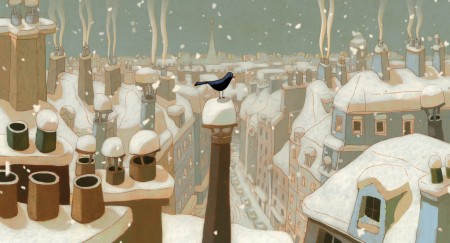
A Cat In Paris
- A Cat In Paris opened officially in New York, yesterday. You may remember that this film, a smidge longer than one hour, was one of five nominees this past year for the Best Animated Feature Oscar. It is a French film animated in 2D and is a satisfying film. It is far from great but also far from bad.
It was a year of films like Cars 2, the sequel to Pixar’s Cars, which had a budget north of $200 million, or Kung Fu Panda 2 the sequel to Dreamworks’ Kung Fu Panda with a budget of $150 million or Puss In Boots, the spin-off of a character from Dreamworks’ Shrek 2 with a budget of $130 million. Two of these three were also nominated for the Oscar (a hint – not the Pixar film.)
This film, The Cat In Paris, received a mix of reviews in NY. The NYTimes‘ A.O.Scott called it, ” . . . a refreshing reminder, at a time of large-scale, highly polished cinematic spectacle, of the essential, elemental sources of movie-watching pleasure.” There was no doubt that Mr. Scott was charmed with the film.
Lou Leminick of The NYPost gave it two stars and wrote, “. . . it seems slight and unremarkable, especially compared to two other wonderful French-language nominees in this category in recent years, “The Triplets of Belleville’’ and “The Illusionist.’’
Michael Atkinson of The Village Voice wrote, “A sketchy trifle of French animation grabbing time in theaters thanks to its recent Oscar nomination . . . seeks shelf space beside Sylvain Chomet’s deft and rapturous hand-drawn cartoons (The Triplets of Belleville, The Illusionist), and the required self-conscious Frenchiness is spot-on.”
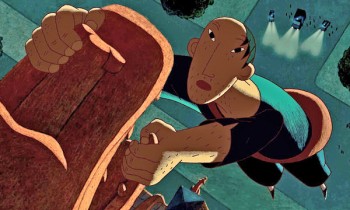 I saw the film last year toward the end of a two week screening of 18 animated features contending for the Oscar nomination. By the time I saw it, I’d been filled with horrendous cgi films like Alvin and the Chipmunks and Puss In Boots and, god help us, Hoodwinked 2. The Cat In Paris came over as the height of sophistication and whimsy. I’m sure I need to see the film again to properly judge it, but I do remember it as nicely designed in a European cartoon style, with a very nice music track and serviceable animation.
I saw the film last year toward the end of a two week screening of 18 animated features contending for the Oscar nomination. By the time I saw it, I’d been filled with horrendous cgi films like Alvin and the Chipmunks and Puss In Boots and, god help us, Hoodwinked 2. The Cat In Paris came over as the height of sophistication and whimsy. I’m sure I need to see the film again to properly judge it, but I do remember it as nicely designed in a European cartoon style, with a very nice music track and serviceable animation.
I enjoyed the movie and am certain I’d feel the same on viewing it again. My thoughts were closer to siding with Mr. Scott’s review in the Times. It wasn’t great; it wasn’t bad. It was a wholly entertaining hour.
- Tom Stathes is one of those incredibly dedicated people who’ve made animation history their life. As a result, the work he’s done, particularly for the silent animated film, has become an enormous contribution to the medium, especially given the internet’s total lack of interest in the subject. This is a rare focus that is wholeheartedly needed for the preservation of that part of the form.
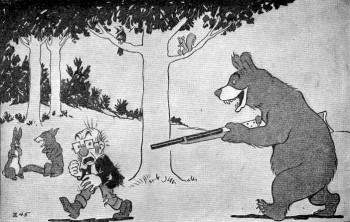 His establishment of the Bray Project has given attention to the studio that was certainly the first very large animation studio in the world with an enormous product and a strong control over the medium of the day. Established in 1911, the Bray Studio produced generally poor cartoons, (most silent cartoons of this period were poor films) but they allowed many pioneers to begin their careers on the right step. From Walter Lantz to Max Fleischer to Paul Terry, many of the giants sat in this studio first.
His establishment of the Bray Project has given attention to the studio that was certainly the first very large animation studio in the world with an enormous product and a strong control over the medium of the day. Established in 1911, the Bray Studio produced generally poor cartoons, (most silent cartoons of this period were poor films) but they allowed many pioneers to begin their careers on the right step. From Walter Lantz to Max Fleischer to Paul Terry, many of the giants sat in this studio first.
Mr. Stathes recently sent out this email note announcing that the Bray Project is now one year old. I thought it important to post the email and give a little nod to Tom and all the great work he’s doing.
- Dearest Friends and Colleagues,
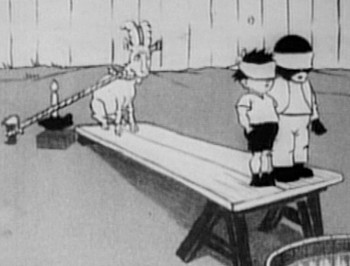 It is now one year since the Bray Animation Project website launched. And it’s been a great year at that!
It is now one year since the Bray Animation Project website launched. And it’s been a great year at that!
Many incredibly exciting rare film finds have been made since the site’s debut and I’ve shared a little bit of information about that in a special blog post here.
The Bray site will see some fixes, updates, and further add-ons in the near future. More excitingly, though, please keep posted for some very important announcements from yours truly to follow in the next few weeks. I once again invite interested parties to discuss research or post questions at the site’s discussion board.
Thank you all for taking an interest in this project or for being a supportive element in my film history and archiving endeavors in general. I wouldn’t be able to achieve much of what I have without the help of many of you.
Cordially,
Tom Stathes
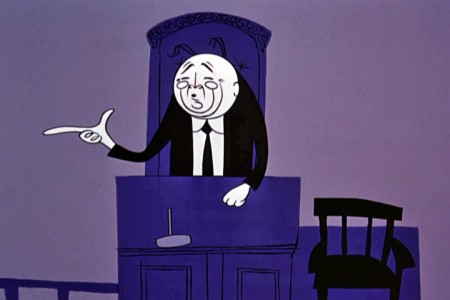 - Thad Komorowski is someone else who continually surprises me with the depth of his knowledge about animation history. I shouldn’t be taken aback whenever I go to his blog and column. The reportage is always first rate, thorough, and the subject is often something I hadn’t even thought about. Yet, a lot of research and work has gone into those columns, and I can only admire them and bookmark their pages so that I can come back and reread it another time or two.
- Thad Komorowski is someone else who continually surprises me with the depth of his knowledge about animation history. I shouldn’t be taken aback whenever I go to his blog and column. The reportage is always first rate, thorough, and the subject is often something I hadn’t even thought about. Yet, a lot of research and work has gone into those columns, and I can only admire them and bookmark their pages so that I can come back and reread it another time or two.
Often, Thad talks about the process rather than the ideology behind the animation. This week, for example, he wrote about the Technicolor backlog once WWII had ended. Studios working in IB Tech weren’t able to get their negatives developed or their print orders met. Waiting years to get their films to market had to have hurt the market, especially given the break up of theater monopolies by the studios. Some of the smaller studios had to turn to Cinecolor to get even second rate prints made. All to go to market.
Thad also gives us an example of a Columbia short that was printed on Cinecolor. We can see how lacking it is in its color quality, and we can also see how dreadful the cartoon is in the quality of its art. It’s one of those shorts you know is so bad you can’t understand why you’re continuing to watch it, yet it’s THAT bad that you can’t stop watching it. The Cinecolor is only the icing on the cake.
And speaking of process just read the posts The WB Production Number Project or MGM Cartoon Filmography by Production Number. These are all about accounting, but since it’s part of the principal production of those glorious Hollywood shorts, it’s information that should be relayed. And I have to say, in my fifty odd years of reading about animation and its history, this is the first time any of these subjecs has come up. It’s not something I need to know, but it’s something I’m astonished to realize I didn’t know. And, believe it or not, this is information I want to have.
As Thad’s work matures, so too his reviews. His lengthy review of Adam Abraham‘s book, When Magoo Flew, is a first rate look at Abraham’s work. It fairly points out the shortcomings of the book, but also tells how important this book is given the lack of other material available on the subject of UPA’s birth. More importantly, Thad has a separate blog post about the Jolly Frolics shorts.
Like most good reviews, there are treasures built into them. Thad appropriately assays Bobe Cannon‘s career in a short and on-target side note. Since Cannon directed many of the most famous UPA cartoons, this is entirely necessary.
- Bobe Cannon was one of animation’s most puzzling treasures. He came up through the ranks at Schlesinger’s and is said to have been critically involved with the concept of smear animation with Chuck Jones. He ultimately abandoned all of what was fun in his own animation in the cartoons he directed at UPA. There are still traces of it in “The Miner’s Daughter” and “Georgie and the Dragon,” and Cannon and Paul Julian (one of the studio’s real unsung heroes) also helmed “Wonder Gloves,” a vastly underrated cartoon with simple but highly pleasing design and animation.
I don’t always agree with Thad, but he gets me to read his evaluation and think about what he’s had to say. Something any good historian or writer would do. I enjoy attending to his blog and appreciate it every time there’s something new. If you’re as much a sucker for animation history as I am, you’ll want to do the same. What About Thad.

on 02 Jun 2012 at 4:19 pm 1.Amid said …
There’s an amazing through line and growth in Cannon’s work from his earlier animation for others through his directorial efforts at UPA and later working again as an animator for Hubley and others. Cannon’s later UPA work (stuff he did between ’52-’56) is not only incredibly fun to watch, but it’s a pinnacle of designed movement in Hollywood theatrical animation. It deserves far better than such a shallow and poorly thought out dismissal.
on 02 Jun 2012 at 4:58 pm 2.Michael said …
I have to agree with you, Amid. There’s a wild looseness in the animation done for the Cannon directed films which perfectly matches the directorial style he uses. The third McBoing Boing isn’t a good film but the way it uses the non-painted characters is just amazing.
This animation style becomes masterful when seen in MOONBIRD or other films that he animated for Hubley. Cannon is the perfect animator for me who uses every rule to break and stretch into pure animation. . . and it’s all done intellectually as well as emotionally.
on 02 Jun 2012 at 6:55 pm 3.Amid said …
Now that’s an insight I can agree with!
on 31 Jul 2012 at 9:03 am 4.Shrek 2001, Shrek 2, Shrek 3, Shrek Movie download Compilation said …
My brother suggested I would possibly like this website. He was totally right. This post actually made my day. You cann’t imagine just how a lot time I had spent for this information! Thanks!
on 12 Jun 2014 at 7:06 am 5.tom and jerry cartoon in urdu said …
Do you have a spam problem on this website; I also am a
blogger, and I was wondering your situation; many of us
have created some nice methods and we are looking to swap methods
with other folks, be sure to shoot me an email if interested.